
Apidae is the largest family within the superfamily Apoidea, containing at least 5700 species of bees. The family includes some of the most commonly seen bees, including bumblebees and honey bees, but also includes stingless bees, carpenter bees, orchid bees, cuckoo bees, and a number of other less widely known groups. Many are valuable pollinators in natural habitats and for agricultural crops.

The tribe Euglossini, in the subfamily Apinae, commonly known as orchid bees or euglossine bees, are the only group of corbiculate bees whose non-parasitic members do not all possess eusocial behavior.

The Apinae are the subfamily that includes the majority of bees in the family Apidae. It includes the familiar "corbiculate" bees—bumblebees, honey bees, orchid bees, stingless bees, and the extinct genus Euglossopteryx. It also includes all but two of the groups that were previously classified in the family Anthophoridae.

Eufriesea is a genus of euglossine bees. Like all orchid bees, they are restricted to the Neotropics.
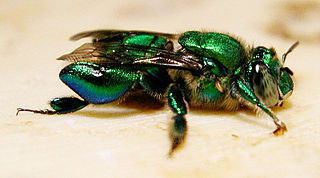
Euglossa is a genus of orchid bees (Euglossini). Like all their close relatives, they are native to the Neotropics; an introduced population exists in Florida. They are typically bright metallic blue, green, coppery, or golden.
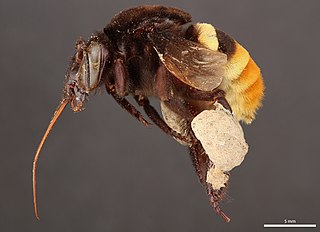
Eulaema is a genus of large-bodied euglossine bees that occur primarily in the Neotropics. They are robust brown or black bees, hairy or velvety, and often striped with yellow or orange, typically resembling bumblebees. They lack metallic coloration as occurs in the related genus Eufriesea.

Exaerete is a genus of euglossine bees found from Mexico to northern Argentina. Like all orchid bees, they are restricted to the Neotropics. All but one species is metallic green, and they are cleptoparasites in the nests of other euglossines in the genera Eufriesea and Eulaema. It contains the following species:

Aglae is a genus of euglossine bees, with the only described species Aglae caerulea. Like all orchid bees, it is restricted to the Neotropics. They are metallic blue. This species, like the genus Exaerete, is a nest parasite on free-living Euglossini. A. caerulea lays its eggs in the nests of Eulaema nigrita, and possibly other Eulaema species.
Pappognatha is a genus of mutillid wasps. Some members of this genus are ant mimics. These wasps occur in Central and South America, and are parasites in the arboreal nests of orchid bees in the genus Euglossa.
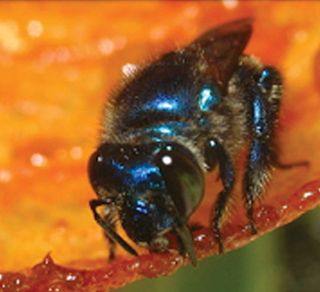
Euglossa hyacinthina, is a species of the orchid bee tribe Euglossini in the family Apidae. With a tongue that can get up to as long as 4 cm, this orchid bee species is found in Central America. Living in a neotropical climate, E.hyacinthina has adapted to hot and humid weather. The bee has darkly shaded, translucent wings and a metallic, glossy blue skeleton.

Euglossa bazinga is a euglossine bee species found in Brazil. It is named after the catchphrase of the fictional character Dr. Sheldon Cooper from the television show The Big Bang Theory. It was previously misidentified as Euglossa ignita, and is threatened with habitat loss.
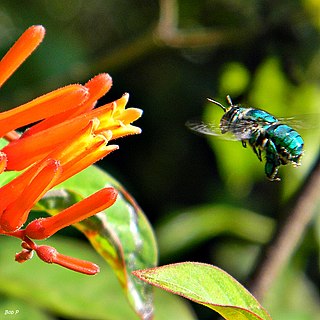
Euglossa dilemma, the green orchid bee or dilemma orchid bee, is a species of solitary euglossine bee native to a broad area of Central America, and recently introduced to Florida in the United States. It was first detected in Broward County, Florida in 2003, and initially identified as Euglossa viridissima, but further study revealed that E. viridissima as previously defined consisted of two cryptic species, and the one present in Florida was new to science.
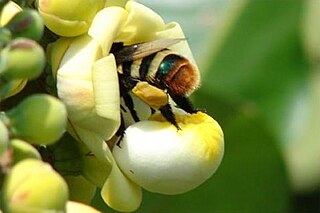
Eulaema meriana is a large-bodied bee species in the tribe Euglossini, otherwise known as the orchid bees. The species is a solitary bee and is native to tropical Central and South America. The male collects fragrances from orchid flowers, which it stores in hollows in its hind legs. Orchids can be deceptive by mimicking the form of a female and her sex pheromone, thus luring male bees or wasps. Pollination will take place as the males attempt to mate with the labellum, or the tip petal of the flower. Male E. meriana are territorial and have a particular perch on a tree trunk where it displays to attract a female. After mating, the female builds a nest with urn-shaped cells made with mud, feces, and plant resin, and provisions these with nectar and pollen before laying an egg in each. These bees also have complex foraging and wing buzzing behaviors and are part of a mimicry complex.

Euglossa cordata is a primitively eusocial orchid bee of the American tropics. The species is known for its green body color and ability to fly distances of over 50 km. Males mostly disperse and leave their home nests, while females have been observed to possess philopatric behavior. Because of this, sightings are rare and little is known about the species. However, it has been observed that adults who pollinate certain species of orchids will become intoxicated during the pollination.
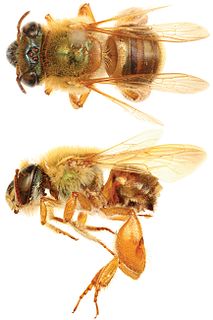
Euglossa decorata is a species of euglossine bee.
Euglossa jacquelynae is a Euglossine bee species found in Central Brazil.
Euglossa sovietica is a Euglossine bee species found in the western Brazilian Amazon. It is believed to be part of the Euglossa purpurea group.

Euglossa imperialis is a bee species in the family Apidae. It is considered to be one of the most important pollinators to many Neotropical orchid species in mainland tropical America. It is also one of the most common non-parasitic euglossine species in lowland Panama. E. imperialis, unlike many other bee species, is not a social bee in the sense that there is no apparent morphological or physiological division within the species to distinguish individual bees to be part of a worker or reproductive caste.

Melipona capixaba, commonly known as uruçu negra in Brazil, is a species of eusocial stingless bees of the order Hymenoptera. It is endemic to the mountainous region of the State of Espirito Santo, Brazil. Since 2003, it has been included on the list of threatened species produced by the Brazilian Ministry of the Environment, and is the only eusocial insect on this list.

Euglossa mixta is a species of orchid bee native to Central America and South America, it is a member of the genus Euglossa a group of brilliant green and blue bees specialized in pollinating certain species of orchids.
















